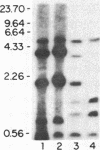Abstract
The X-chromosome-linked glucose-6-phosphate dehydrogenase (D-glucose-6-phosphate:NADP+ oxidoreductase, EC 1.1.1.49) of humans and other mammals consists of a subunit with a molecular weight of about 58,000. The enzyme plays a key role in the generation of NADPH, particularly in matured erythrocytes, and the genetic deficiency of the enzyme is associated with chronic and drug- or food-induced hemolytic anemia in humans. The enzyme was purified to homogeneity from human erythrocytes. The complete amino acid sequence of the subunit, consisting of 531 amino acid residues, was determined by automated and manual Edman degradation of tryptic, chymotryptic, thermolytic, and cyanogen bromide peptides obtained from the enzyme. Based on the amino acid sequence data thus obtained, a 41-mer oligonucleotide with unique sequence was prepared. Two cDNA libraries constructed in phage lambda gt11--i.e., a human liver cDNA library and a human hepatoma Li-7 cDNA library--were screened with the synthetic nucleotide probe. Two positive clones, lambda G6PD-19 and lambda G6PD-25, were obtained from the hepatoma library. lambda G6PD-19 contained an insertion of 2.0 kilobase pairs (kbp), and encoded 204 amino acid residues that were completely compatible with the COOH-terminal portion of the enzyme. The insertion of the clone had a 3' noncoding region of 1.36 kbp. The other clone, lambda G6PD-25, had an insertion of 1.8 kbp and encoded 362 amino acid residues of G6PD. Southern blot analysis of DNA samples obtained from cells with and without the human X chromosome indicated that the cDNA hybridizes with a sequence in the X chromosome.
Full text
PDF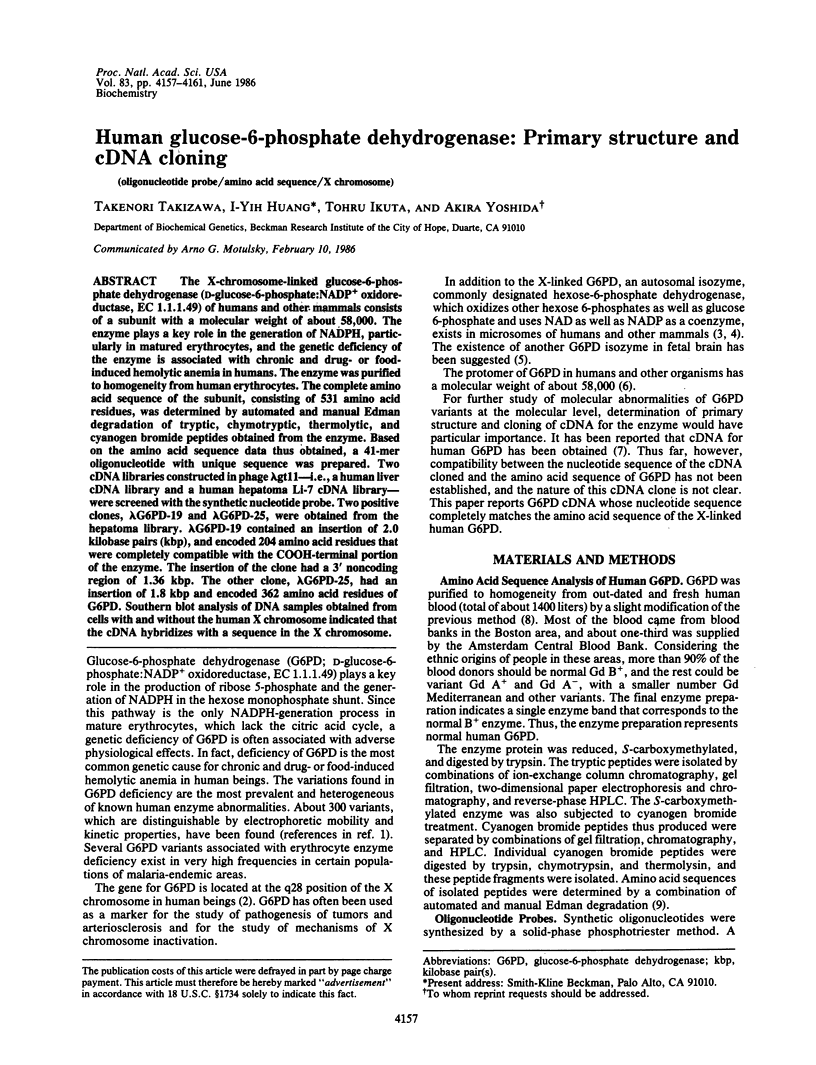
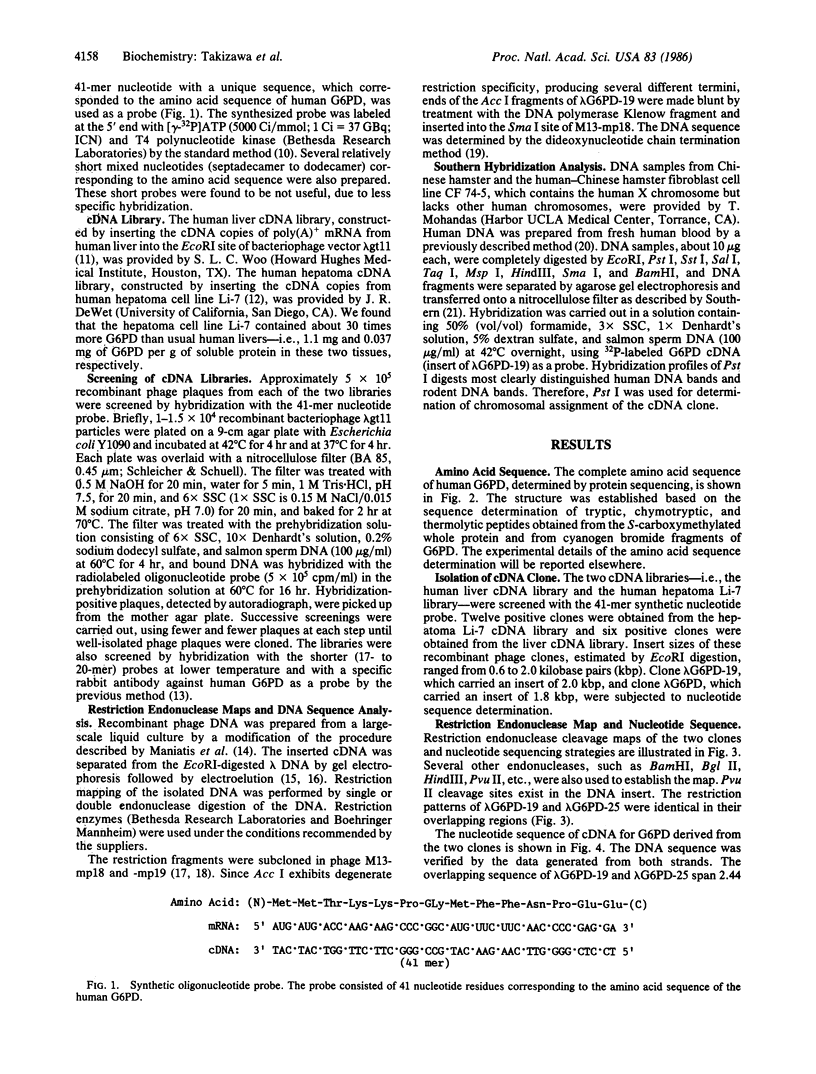
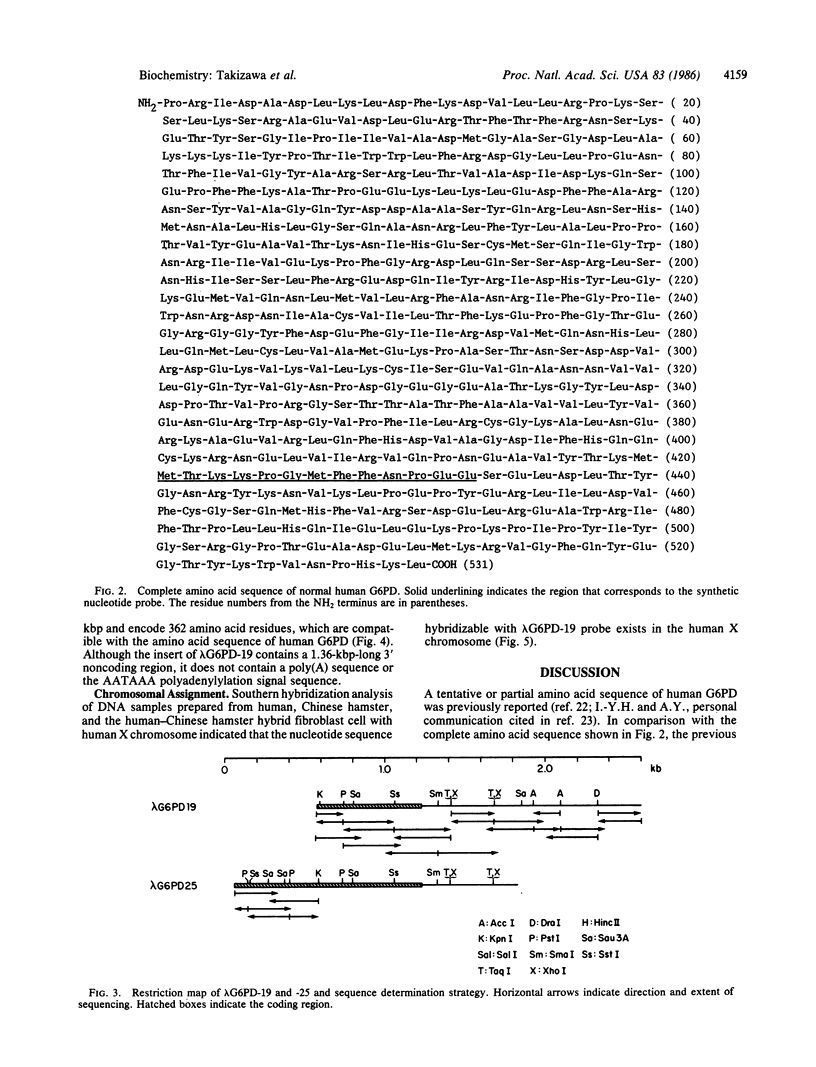
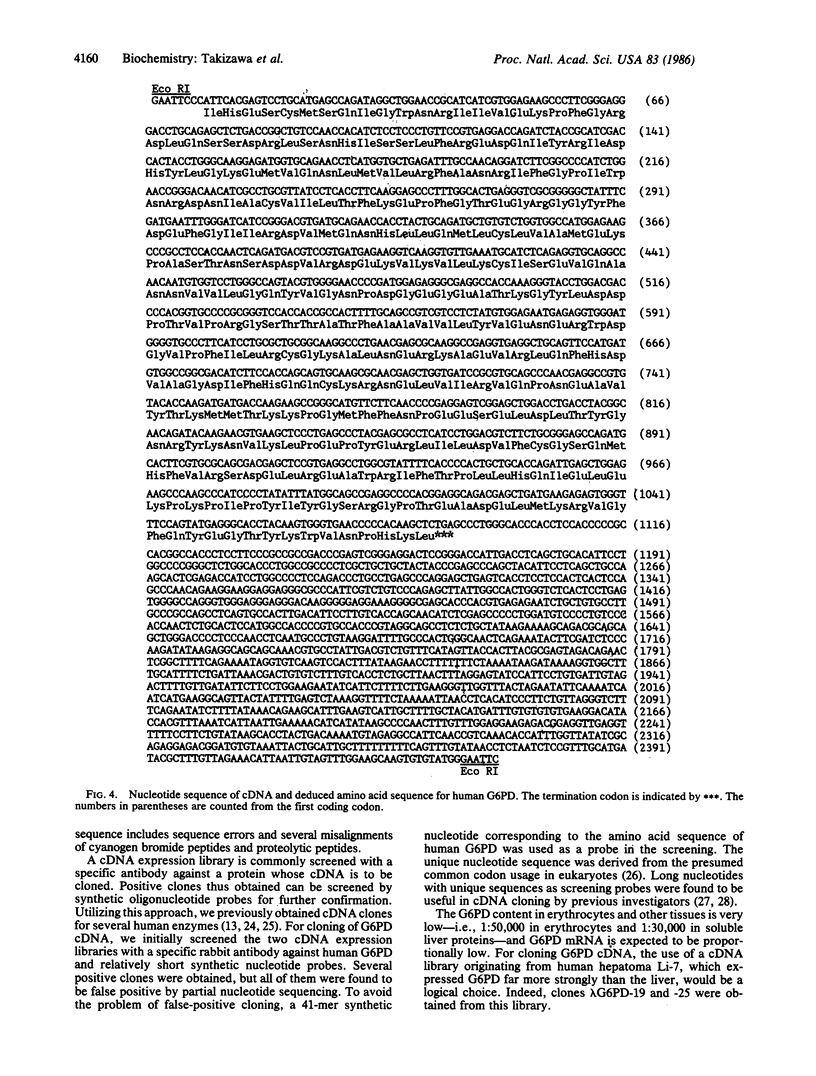
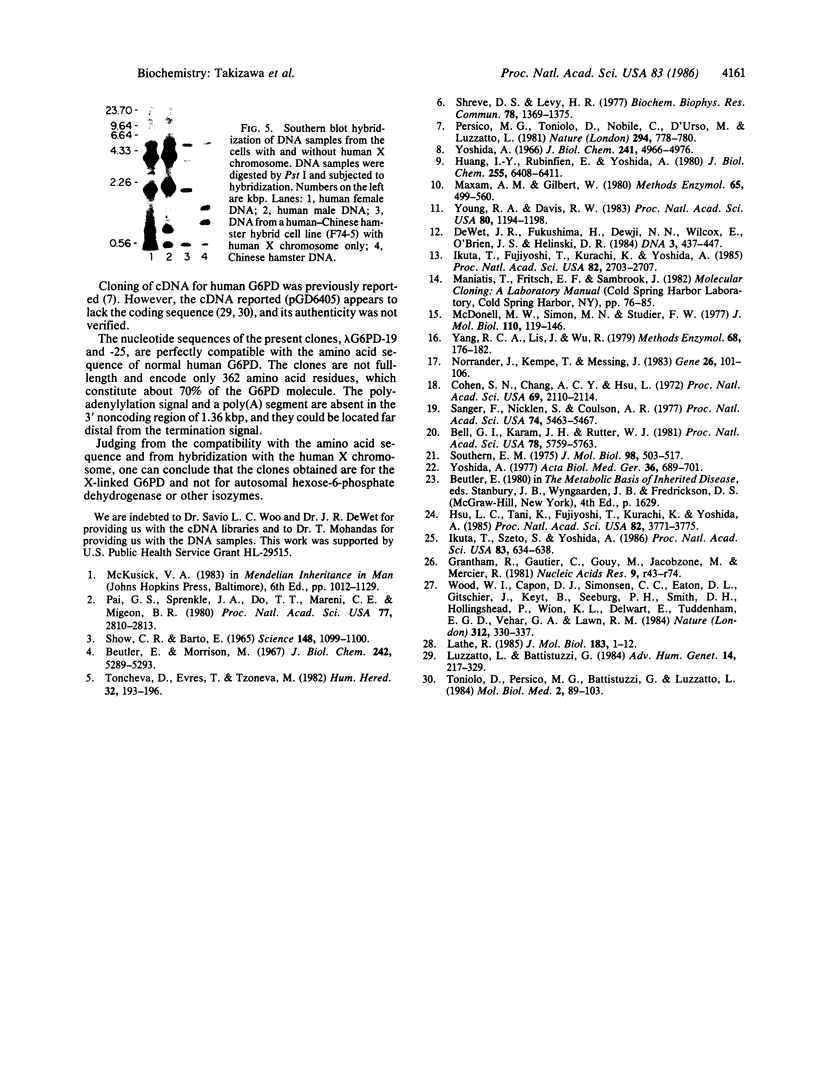
Images in this article
Selected References
These references are in PubMed. This may not be the complete list of references from this article.
- Bell G. I., Karam J. H., Rutter W. J. Polymorphic DNA region adjacent to the 5' end of the human insulin gene. Proc Natl Acad Sci U S A. 1981 Sep;78(9):5759–5763. doi: 10.1073/pnas.78.9.5759. [DOI] [PMC free article] [PubMed] [Google Scholar]
- Beutler E., Morrison M. Localization and characteristics of hexose 6-phosphate dehydrogenase (glucose dehydrogenase). J Biol Chem. 1967 Nov 25;242(22):5289–5293. [PubMed] [Google Scholar]
- Cohen S. N., Chang A. C., Hsu L. Nonchromosomal antibiotic resistance in bacteria: genetic transformation of Escherichia coli by R-factor DNA. Proc Natl Acad Sci U S A. 1972 Aug;69(8):2110–2114. doi: 10.1073/pnas.69.8.2110. [DOI] [PMC free article] [PubMed] [Google Scholar]
- Grantham R., Gautier C., Gouy M., Jacobzone M., Mercier R. Codon catalog usage is a genome strategy modulated for gene expressivity. Nucleic Acids Res. 1981 Jan 10;9(1):r43–r74. doi: 10.1093/nar/9.1.213-b. [DOI] [PMC free article] [PubMed] [Google Scholar]
- Hsu L. C., Tani K., Fujiyoshi T., Kurachi K., Yoshida A. Cloning of cDNAs for human aldehyde dehydrogenases 1 and 2. Proc Natl Acad Sci U S A. 1985 Jun;82(11):3771–3775. doi: 10.1073/pnas.82.11.3771. [DOI] [PMC free article] [PubMed] [Google Scholar]
- Huang I. Y., Rubinfien E., Yoshida A. Complete amino acid sequence of human phosphoglycerate kinase. Isolation and amino acid sequence of tryptic peptides. J Biol Chem. 1980 Jul 10;255(13):6408–6411. [PubMed] [Google Scholar]
- Ikuta T., Fujiyoshi T., Kurachi K., Yoshida A. Molecular cloning of a full-length cDNA for human alcohol dehydrogenase. Proc Natl Acad Sci U S A. 1985 May;82(9):2703–2707. doi: 10.1073/pnas.82.9.2703. [DOI] [PMC free article] [PubMed] [Google Scholar]
- Ikuta T., Szeto S., Yoshida A. Three human alcohol dehydrogenase subunits: cDNA structure and molecular and evolutionary divergence. Proc Natl Acad Sci U S A. 1986 Feb;83(3):634–638. doi: 10.1073/pnas.83.3.634. [DOI] [PMC free article] [PubMed] [Google Scholar]
- Lathe R. Synthetic oligonucleotide probes deduced from amino acid sequence data. Theoretical and practical considerations. J Mol Biol. 1985 May 5;183(1):1–12. doi: 10.1016/0022-2836(85)90276-1. [DOI] [PubMed] [Google Scholar]
- Luzzatto L., Battistuzzi G. Glucose-6-phosphate dehydrogenase. Adv Hum Genet. 1985;14:217-329, 386-8. doi: 10.1007/978-1-4615-9400-0_4. [DOI] [PubMed] [Google Scholar]
- Maxam A. M., Gilbert W. Sequencing end-labeled DNA with base-specific chemical cleavages. Methods Enzymol. 1980;65(1):499–560. doi: 10.1016/s0076-6879(80)65059-9. [DOI] [PubMed] [Google Scholar]
- McDonell M. W., Simon M. N., Studier F. W. Analysis of restriction fragments of T7 DNA and determination of molecular weights by electrophoresis in neutral and alkaline gels. J Mol Biol. 1977 Feb 15;110(1):119–146. doi: 10.1016/s0022-2836(77)80102-2. [DOI] [PubMed] [Google Scholar]
- Norrander J., Kempe T., Messing J. Construction of improved M13 vectors using oligodeoxynucleotide-directed mutagenesis. Gene. 1983 Dec;26(1):101–106. doi: 10.1016/0378-1119(83)90040-9. [DOI] [PubMed] [Google Scholar]
- Pai G. S., Sprenkle J. A., Do T. T., Mareni C. E., Migeon B. R. Localization of loci for hypoxanthine phosphoribosyltransferase and glucose-6-phosphate dehydrogenase and biochemical evidence of nonrandom X chromosome expression from studies of a human X-autosome translocation. Proc Natl Acad Sci U S A. 1980 May;77(5):2810–2813. doi: 10.1073/pnas.77.5.2810. [DOI] [PMC free article] [PubMed] [Google Scholar]
- Persico M. G., Toniolo D., Nobile C., D'Urso M., Luzzatto L. cDNA sequences of human glucose 6-phosphate dehydrogenase cloned in pBR322. Nature. 1981 Dec 24;294(5843):778–780. doi: 10.1038/294778a0. [DOI] [PubMed] [Google Scholar]
- SHAW C. R., BARTO E. AUTOSOMALLY DETERMINED POLYMORPHISM OF GLUCOSE-6-PHOSPHATE DEHYDROGENASE IN PEROMYSCUS. Science. 1965 May 21;148(3673):1099–1100. doi: 10.1126/science.148.3673.1099. [DOI] [PubMed] [Google Scholar]
- Sanger F., Nicklen S., Coulson A. R. DNA sequencing with chain-terminating inhibitors. Proc Natl Acad Sci U S A. 1977 Dec;74(12):5463–5467. doi: 10.1073/pnas.74.12.5463. [DOI] [PMC free article] [PubMed] [Google Scholar]
- Shreve D. S., Levy H. R. On the molecular weight of human glucose 6-phosphate dehydrogenase. Biochem Biophys Res Commun. 1977 Oct 24;78(4):1369–1375. doi: 10.1016/0006-291x(77)91443-7. [DOI] [PubMed] [Google Scholar]
- Southern E. M. Detection of specific sequences among DNA fragments separated by gel electrophoresis. J Mol Biol. 1975 Nov 5;98(3):503–517. doi: 10.1016/s0022-2836(75)80083-0. [DOI] [PubMed] [Google Scholar]
- Toncheva D., Evrev T., Tzoneva M. G6PD in immature and mature human brain. Electrophoretic and enzyme kinetic studies. Hum Hered. 1982;32(3):193–196. doi: 10.1159/000153290. [DOI] [PubMed] [Google Scholar]
- Toniolo D., Persico M. G., Battistuzzi G., Luzzatto L. Partial purification and characterization of the messenger RNA for human glucose-6-phosphate dehydrogenase. Mol Biol Med. 1984 Apr;2(2):89–103. [PubMed] [Google Scholar]
- Wood W. I., Capon D. J., Simonsen C. C., Eaton D. L., Gitschier J., Keyt B., Seeburg P. H., Smith D. H., Hollingshead P., Wion K. L. Expression of active human factor VIII from recombinant DNA clones. Nature. 1984 Nov 22;312(5992):330–337. doi: 10.1038/312330a0. [DOI] [PubMed] [Google Scholar]
- Yang R., Lis J., Wu R. Elution of DNA from agarose gels after electrophoresis. Methods Enzymol. 1979;68:176–182. doi: 10.1016/0076-6879(79)68012-6. [DOI] [PubMed] [Google Scholar]
- Yoshida A. Glucose 6-phosphate dehydrogenase of human erythrocytes. I. Purification and characterization of normal (B+) enzyme. J Biol Chem. 1966 Nov 10;241(21):4966–4976. [PubMed] [Google Scholar]
- Yoshida A. Glucose-6-phosphate dehydrogenase abnormality and hemolysis. Acta Biol Med Ger. 1977;36(5-6):689–701. [PubMed] [Google Scholar]
- Young R. A., Davis R. W. Efficient isolation of genes by using antibody probes. Proc Natl Acad Sci U S A. 1983 Mar;80(5):1194–1198. doi: 10.1073/pnas.80.5.1194. [DOI] [PMC free article] [PubMed] [Google Scholar]
- de Wet J. R., Fukushima H., Dewji N. N., Wilcox E., O'Brien J. S., Helinski D. R. Chromogenic immunodetection of human serum albumin and alpha-L-fucosidase clones in a human hepatoma cDNA expression library. DNA. 1984 Dec;3(6):437–447. doi: 10.1089/dna.1.1984.3.437. [DOI] [PubMed] [Google Scholar]



